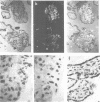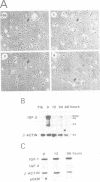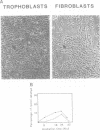Abstract
Substructures of the first-trimester human placenta (within 3 months post-conception) display 'pseudo-malignant' properties. We show here, by in situ hybridization, that the insulin-like growth factor 2 (IGF-2) gene expression is particularly active in the cytotrophoblasts, which dominate these structures. Because the majority of placental IGF-2 mRNA is polysomal in extracts of first-trimester placenta, the spatial pattern of IGF-2 transcripts generally also defines the pattern of IGF-2 production. In primary trophoblast cultures, rendered quiescent by serum starvation. IGF-2 performs as a human embryonic growth factor by activating cell cycle entry/progression. Although both type 1 and 2 IGF receptor mRNAs can be found co-distributed with IGF-2 mRNA during placental development (supporting an autocrine role for IGF-2), these occasional patterns are confined to cytotrophoblasts with low proliferative potential. The reciprocity in ligand and receptor expression patterns are discussed in terms of rate-limiting steps in the involvement of IGF-2 in the proliferative phenotype of the early human placenta.
Full text
PDF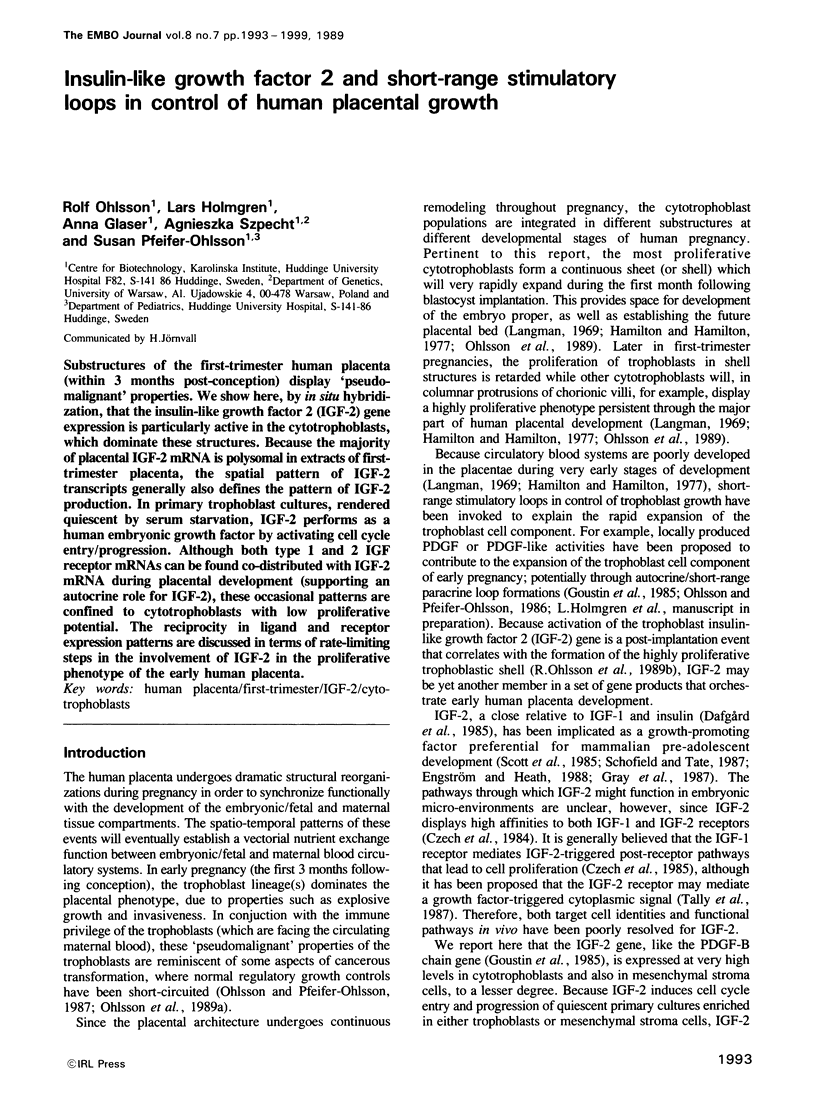
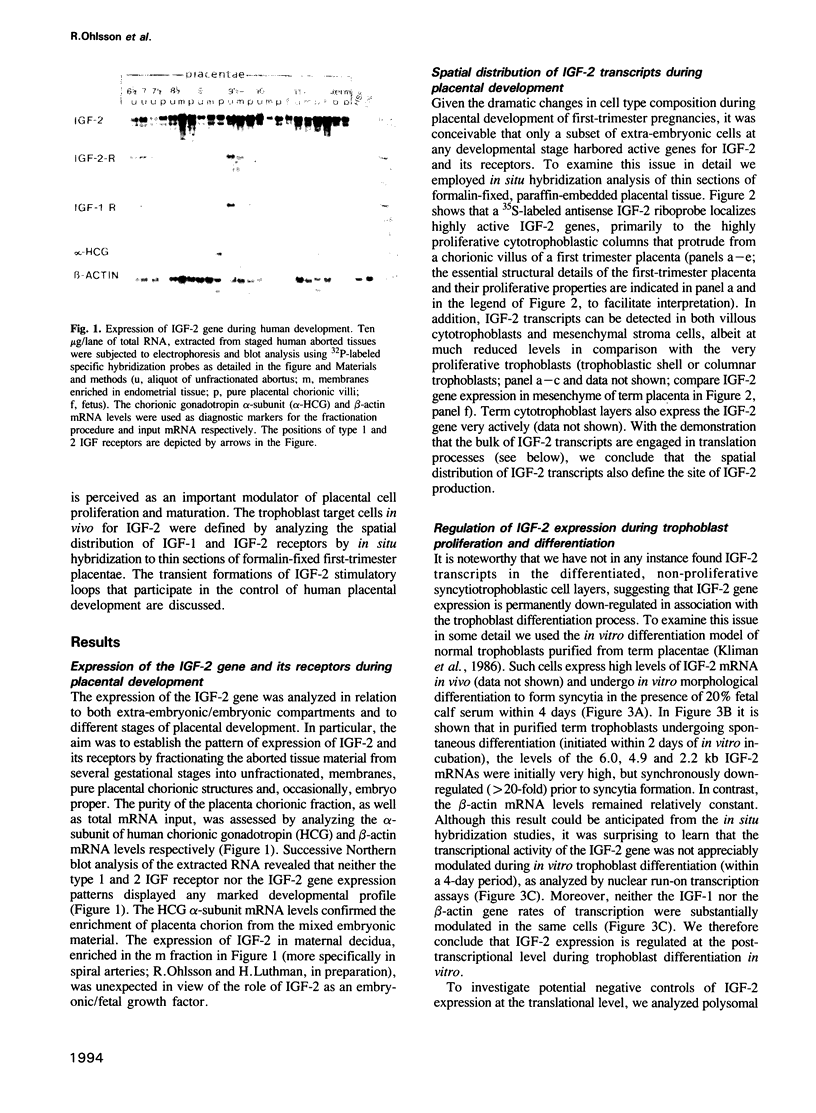
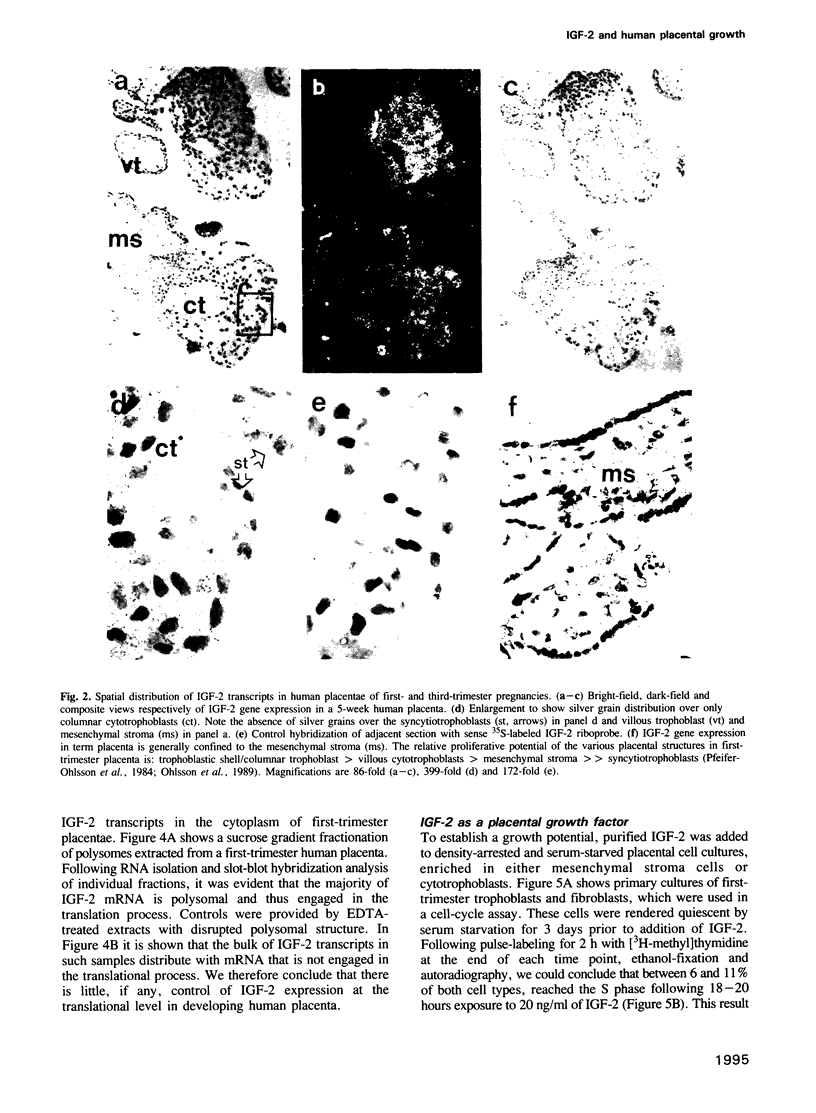
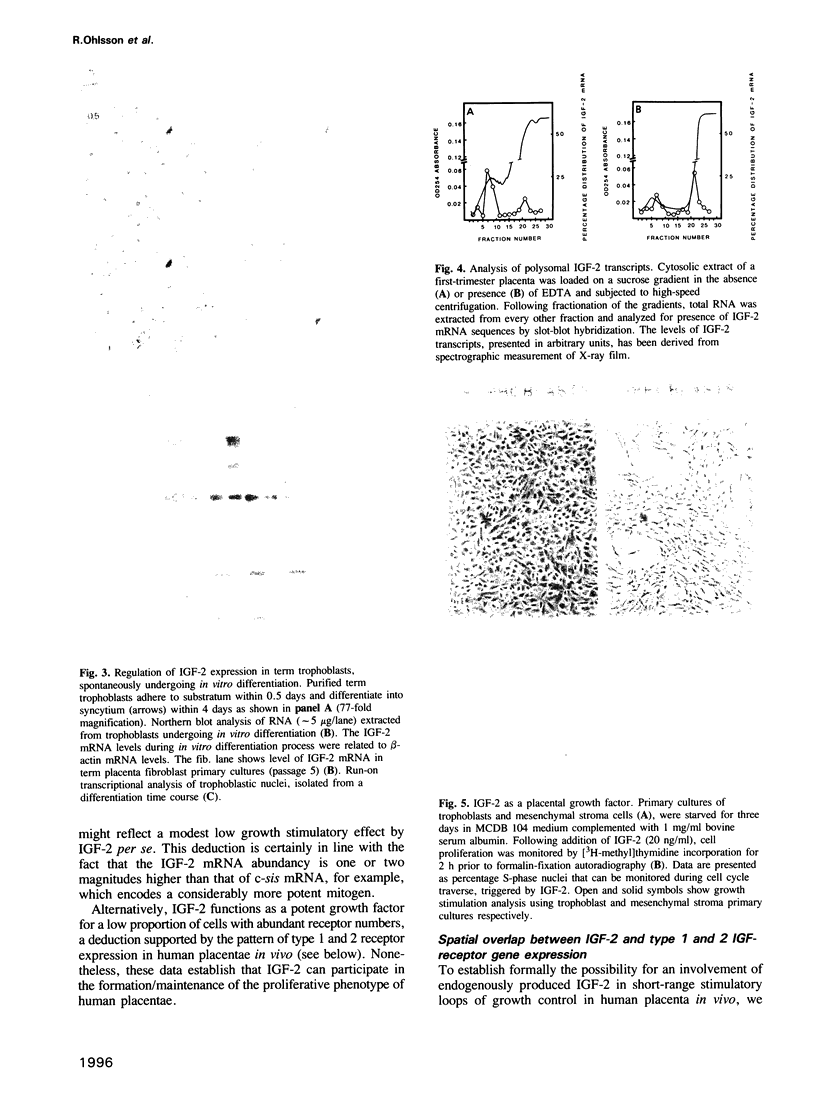
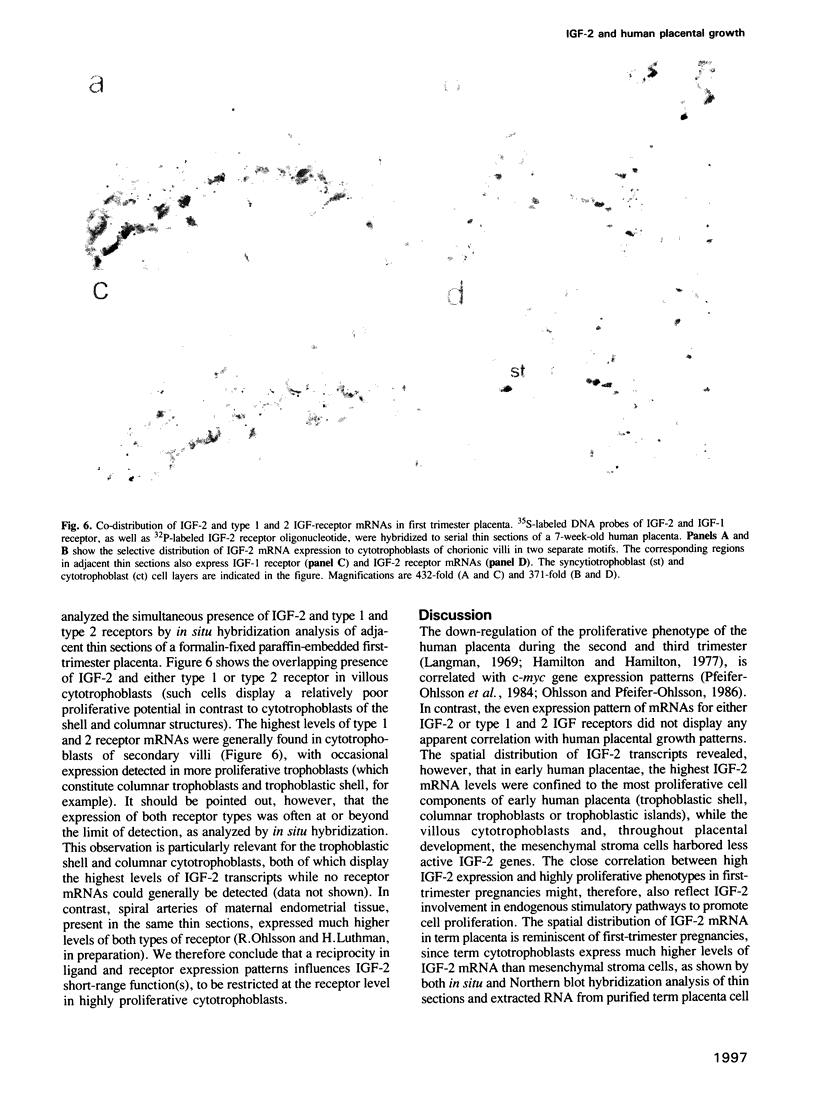
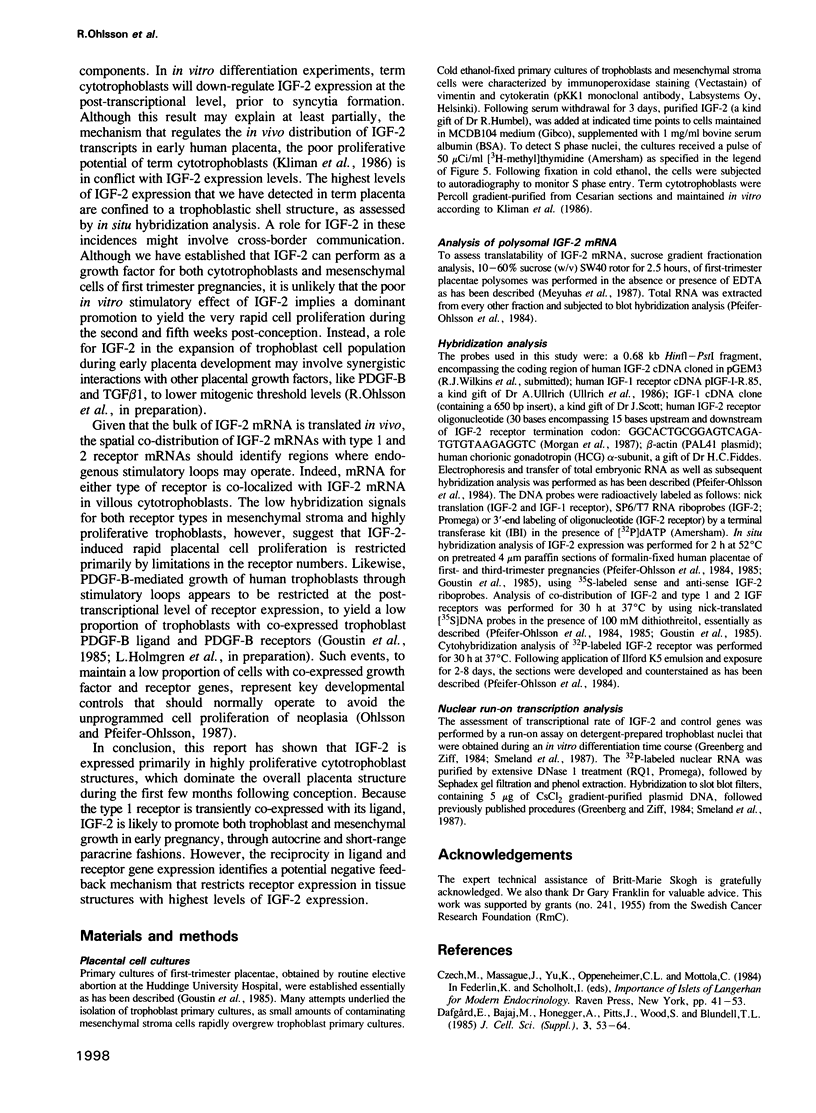
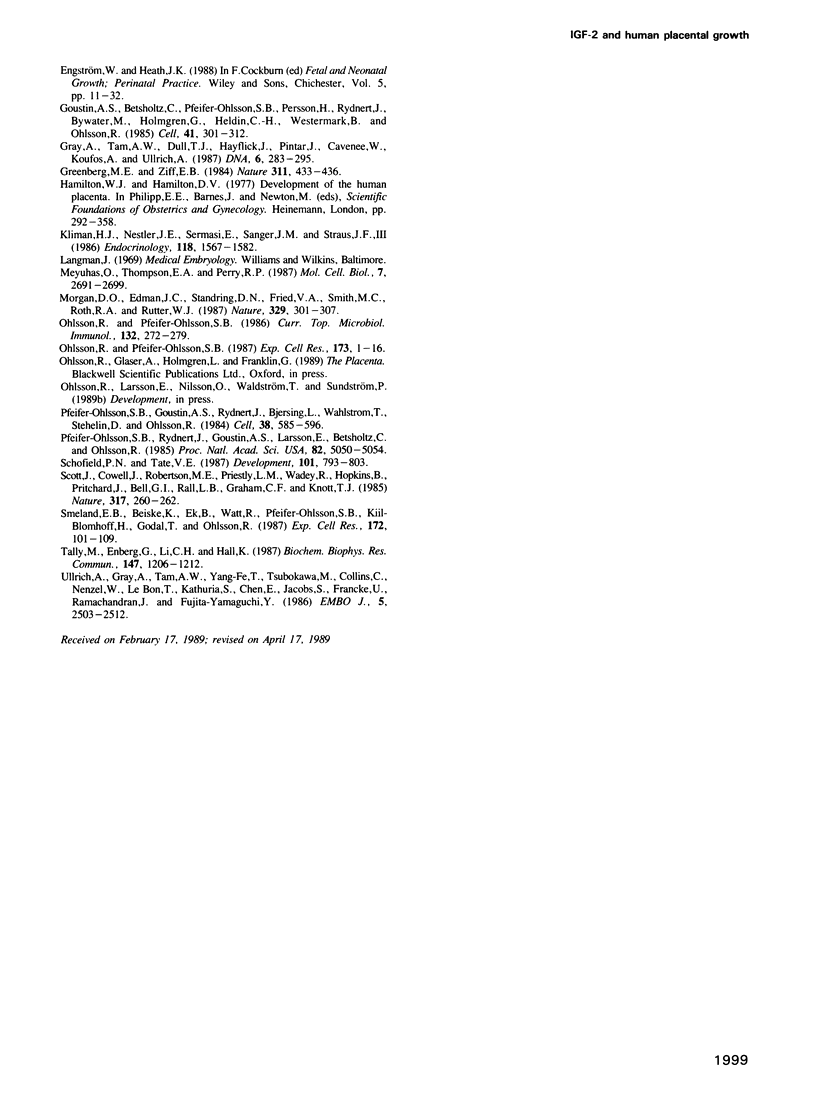
Images in this article
Selected References
These references are in PubMed. This may not be the complete list of references from this article.
- Dafgård E., Bajaj M., Honegger A. M., Pitts J., Wood S., Blundell T. The conformation of insulin-like growth factors: relationships with insulins. J Cell Sci Suppl. 1985;3:53–64. doi: 10.1242/jcs.1985.supplement_3.6. [DOI] [PubMed] [Google Scholar]
- Goustin A. S., Betsholtz C., Pfeifer-Ohlsson S., Persson H., Rydnert J., Bywater M., Holmgren G., Heldin C. H., Westermark B., Ohlsson R. Coexpression of the sis and myc proto-oncogenes in developing human placenta suggests autocrine control of trophoblast growth. Cell. 1985 May;41(1):301–312. doi: 10.1016/0092-8674(85)90083-2. [DOI] [PubMed] [Google Scholar]
- Gray A., Tam A. W., Dull T. J., Hayflick J., Pintar J., Cavenee W. K., Koufos A., Ullrich A. Tissue-specific and developmentally regulated transcription of the insulin-like growth factor 2 gene. DNA. 1987 Aug;6(4):283–295. doi: 10.1089/dna.1987.6.283. [DOI] [PubMed] [Google Scholar]
- Greenberg M. E., Ziff E. B. Stimulation of 3T3 cells induces transcription of the c-fos proto-oncogene. Nature. 1984 Oct 4;311(5985):433–438. doi: 10.1038/311433a0. [DOI] [PubMed] [Google Scholar]
- Kliman H. J., Nestler J. E., Sermasi E., Sanger J. M., Strauss J. F., 3rd Purification, characterization, and in vitro differentiation of cytotrophoblasts from human term placentae. Endocrinology. 1986 Apr;118(4):1567–1582. doi: 10.1210/endo-118-4-1567. [DOI] [PubMed] [Google Scholar]
- Meyuhas O., Thompson E. A., Jr, Perry R. P. Glucocorticoids selectively inhibit translation of ribosomal protein mRNAs in P1798 lymphosarcoma cells. Mol Cell Biol. 1987 Aug;7(8):2691–2699. doi: 10.1128/mcb.7.8.2691. [DOI] [PMC free article] [PubMed] [Google Scholar]
- Morgan D. O., Edman J. C., Standring D. N., Fried V. A., Smith M. C., Roth R. A., Rutter W. J. Insulin-like growth factor II receptor as a multifunctional binding protein. Nature. 1987 Sep 24;329(6137):301–307. doi: 10.1038/329301a0. [DOI] [PubMed] [Google Scholar]
- Ohlsson R. I., Pfeifer-Ohlsson S. B. Cancer genes, proto-oncogenes, and development. Exp Cell Res. 1987 Nov;173(1):1–16. doi: 10.1016/0014-4827(87)90327-2. [DOI] [PubMed] [Google Scholar]
- Ohlsson R. I., Pfeifer-Ohlsson S. myc expression in vivo during human embryogenesis. Curr Top Microbiol Immunol. 1986;132:272–279. doi: 10.1007/978-3-642-71562-4_41. [DOI] [PubMed] [Google Scholar]
- Pfeifer-Ohlsson S., Goustin A. S., Rydnert J., Wahlström T., Bjersing L., Stehelin D., Ohlsson R. Spatial and temporal pattern of cellular myc oncogene expression in developing human placenta: implications for embryonic cell proliferation. Cell. 1984 Sep;38(2):585–596. doi: 10.1016/0092-8674(84)90513-0. [DOI] [PubMed] [Google Scholar]
- Pfeifer-Ohlsson S., Rydnert J., Goustin A. S., Larsson E., Betsholtz C., Ohlsson R. Cell-type-specific pattern of myc protooncogene expression in developing human embryos. Proc Natl Acad Sci U S A. 1985 Aug;82(15):5050–5054. doi: 10.1073/pnas.82.15.5050. [DOI] [PMC free article] [PubMed] [Google Scholar]
- Schofield P. N., Tate V. E. Regulation of human IGF-II transcription in fetal and adult tissues. Development. 1987 Dec;101(4):793–803. doi: 10.1242/dev.101.4.793. [DOI] [PubMed] [Google Scholar]
- Scott J., Cowell J., Robertson M. E., Priestley L. M., Wadey R., Hopkins B., Pritchard J., Bell G. I., Rall L. B., Graham C. F. Insulin-like growth factor-II gene expression in Wilms' tumour and embryonic tissues. Nature. 1985 Sep 19;317(6034):260–262. doi: 10.1038/317260a0. [DOI] [PubMed] [Google Scholar]
- Smeland E. B., Beiske K., Ek B., Watt R., Pfeifer-Ohlsson S., Blomhoff H. K., Godal T., Ohlsson R. Regulation of c-myc transcription and protein expression during activation of normal human B cells. Exp Cell Res. 1987 Sep;172(1):101–109. doi: 10.1016/0014-4827(87)90097-8. [DOI] [PubMed] [Google Scholar]
- Tally M., Enberg G., Li C. H., Hall K. The specificity of the human IGF-2 receptor. Biochem Biophys Res Commun. 1987 Sep 30;147(3):1206–1212. doi: 10.1016/s0006-291x(87)80198-5. [DOI] [PubMed] [Google Scholar]
- Ullrich A., Gray A., Tam A. W., Yang-Feng T., Tsubokawa M., Collins C., Henzel W., Le Bon T., Kathuria S., Chen E. Insulin-like growth factor I receptor primary structure: comparison with insulin receptor suggests structural determinants that define functional specificity. EMBO J. 1986 Oct;5(10):2503–2512. doi: 10.1002/j.1460-2075.1986.tb04528.x. [DOI] [PMC free article] [PubMed] [Google Scholar]




